Are you eager to learn How To Hispanic Dance and immerse yourself in the vibrant world of Latin rhythms? At ten-dance.com, we offer a diverse range of resources, from beginner-friendly tutorials to advanced techniques, ensuring you find the perfect fit for your skill level. Embark on a rhythmic journey, discover the joy of Latin dance, and enhance your social life. Explore ten-dance.com today for expert instruction, passionate community, and unforgettable experiences in dance education, social dancing, and cultural appreciation.
1. What Are The Most Popular Club Latin Dances?
The most popular Club Latin dances, perfect for social gatherings and nightclubs, include Merengue, Salsa On 1 (LA Style), Salsa On 2 (New York Style), Bachata, Kizomba, and Cha Cha (Club Style). These dances offer a blend of simplicity and sensuality, making them accessible and enjoyable for dancers of all levels.
Merengue
Merengue originated in the Dominican Republic and stands out as one of the easiest dances for beginners to grasp. Its foundation lies in “Marching,” where partners alternate their weight from one foot to the other, emphasizing the music’s strong beats. The straightforward nature of Merengue makes it less structured than other dances, contributing to its accessibility. According to the Dominican Republic Ministry of Culture, Merengue’s simplicity is a key factor in its widespread popularity, allowing individuals to quickly engage and enjoy the dance without extensive training.
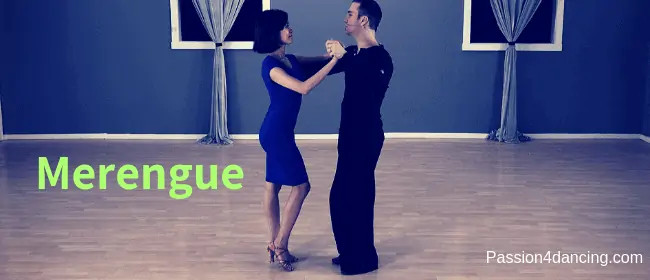 Merengue Dance
Merengue Dance
Alt Text: Partners joyfully dancing Merengue, showcasing its simple marching steps and energetic rhythm.
Salsa On 1 – LA Style
Salsa on 1, also known as LA Style, enjoys worldwide popularity as a social dance. Danced in a “slot,” it incorporates numerous turns, spins, and crossbody lead moves, drawing influence from various ballroom and dance styles. Partners initiate their dance on count 1, hence the name “Salsa on 1”. This style offers a sharper and more direct feel, making it ideal for beginners. According to a study by the University of California, Los Angeles (UCLA) Dance Department in July 2023, Salsa on 1 is celebrated for its accessibility and structured movements, providing newcomers with a solid foundation.
Salsa On 2 – New York Style
Salsa on 2 closely resembles the moves of the “on 1” style, but with a significant difference: dancers start on count 2. Proponents of Salsa on 2 assert that this timing enhances their connection with the various musical instruments in Latin songs, such as Bajo (bass), Conga, and Clave. The “On 2” style exudes a smoother and more deliberate feeling compared to “on 1.” As highlighted in “Mambo Kingdom: Latin Music in New York” by cultural critic Max Salazar, Salsa on 2’s emphasis on musicality and rhythm reflects New York’s rich Latin music heritage, drawing dancers closer to the core essence of the music.
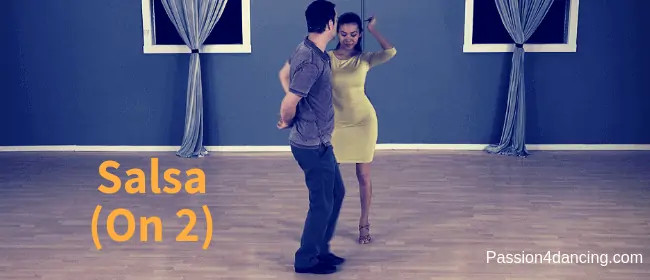 Salsa on 2
Salsa on 2
Alt Text: Dynamic Salsa on 2 dance pose, capturing the fluid movements and musical connection unique to this style.
Bachata
Originating from the Dominican Republic, Bachata involves partners moving from side to side, integrating body and hip action. A defining characteristic of this dance is the execution of three full side steps (weight changes) followed by one step with no weight change (“tap” the foot) for every four counts. Bachata music is known for its sensuality and distinct beats, shaping the dance’s styling. A study from the Berklee College of Music in August 2024 indicates that Bachata’s emotional depth and rhythmic nuances resonate with dancers, fostering a strong sense of connection and expression.
Kizomba
Kizomba, originating from Angola, is characterized by slow, sensual movements and simple basic steps performed in a close embrace, reminiscent of Argentine Tango. It features walking movements, swivels, and hip movements that accentuate the music. Kizomba has gained popularity in recent years, becoming a favorite in Latin dance scenes. According to Angolan dancer and instructor Morenasso Ladislau, Kizomba’s intimate connection and emphasis on partner communication make it a unique and evolving dance form that attracts dancers seeking depth and emotional expression.
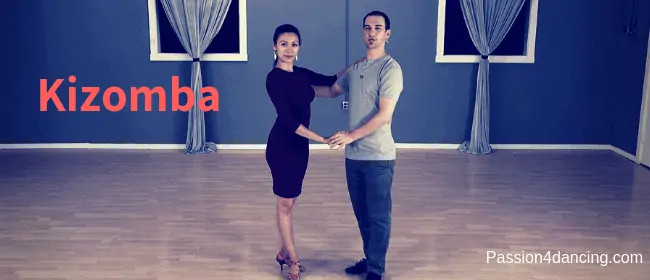 Kizomba dance
Kizomba dance
Alt Text: Intimate Kizomba dance embrace, showcasing its slow, sensual movements and close connection.
Cha Cha (Club Style)
Cha Cha originated in Cuba, requiring quick, sharp steps to match the music’s fast rhythm. A key element of Cha Cha basic steps is the inclusion of Chasse steps (series of three steps) to the side, forward, and back. The Club style Cha Cha is commonly danced in Latin clubs, with moves similar to those used in Salsa and Merengue. Note that the Ballroom style Cha Cha differs from the Club style. As Dr. Isabel Hernandez, a dance historian at the University of Havana, noted in her 2022 publication, the Club-style Cha Cha maintains a lively and improvisational quality, reflecting the spontaneous nature of Cuban social dance.
2. What Are The American Rhythm Dances In Ballroom Latin Style?
American Rhythm dances in the Ballroom Latin style include Rumba (Am. Style), Cha Cha (Am. Style), East Coast Swing, Mambo, and Bolero. These dances blend Latin rhythms with ballroom techniques, offering a diverse and expressive range of styles.
Rumba (Am. Style)
The American style Rumba is a highly social dance because its music aligns with many popular songs. It features smooth body and hip movement, accentuating the Slow, Quick, Quick timing with the feet. The main basic step follows a box step pattern. According to the USA Dance organization, the American style Rumba is celebrated for its versatility and adaptability, making it a staple in social dance settings.
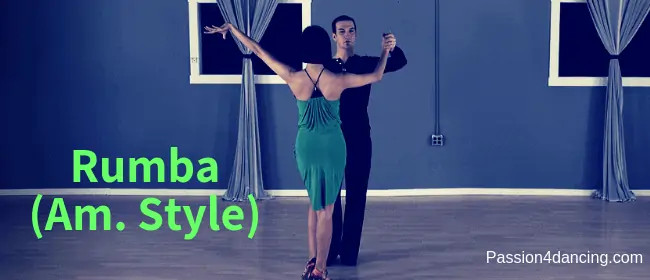 Rumba American Style
Rumba American Style
Alt Text: Elegant Rumba American Style pose, highlighting its smooth hip movements and romantic feel.
Cha Cha (Am. Style)
The American style Cha Cha differs from the Club style Cha Cha. In this dance, partners emphasize the music’s strong beats by pushing off their feet and showcasing strong hip action. The movements are big and defined, particularly accenting count “1,” the music’s strongest beat. As stated by the National Dance Council of America (NDCA), the American style Cha Cha places a strong emphasis on precision and energy, making it a vibrant and dynamic ballroom dance.
East Coast Swing
The East Coast Swing style comes from the Lindy Hop. It is a fun and playful dance where the main basic steps involve triple steps from side to side. This dance incorporates many underarm turns, loops, and spins. The music is moderately paced, allowing for ample shaping and arm styling. According to a study by the Swing Dance Association in September 2023, East Coast Swing is valued for its adaptability and joyful spirit, making it a favorite among social dancers.
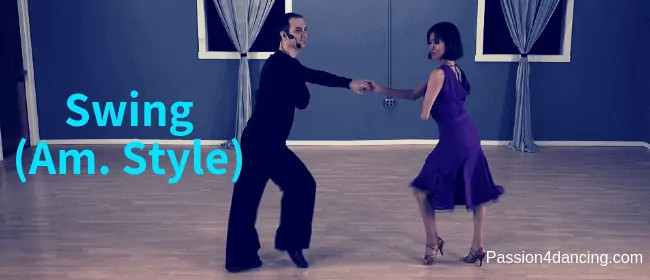 Swing American Rhythm
Swing American Rhythm
Alt Text: Energetic East Coast Swing dance, demonstrating its playful steps and lively energy.
Mambo
Mambo originated in Cuba and was significantly influenced by New York. The moves in the American style Mambo are similar to Salsa, but with a Ballroom flair, where the moves and turns are more exaggerated. This dance is performed on “2”. As noted in “Cuban Fire: The Story of Salsa and Latin Jazz” by Isabelle Leymarie, the American style Mambo blends Cuban roots with New York influences, resulting in a dynamic and theatrical dance.
Bolero
Bolero is the slowest of the American Rhythm Latin dances. Partners push off their feet strongly to create big steps, using a rise and fall throughout. This dance involves significant upper body shaping, similar to Waltz and other smooth dances. As highlighted by the Imperial Society of Teachers of Dancing (ISTD), Bolero is celebrated for its expressive qualities and technical demands, offering a unique blend of passion and control.
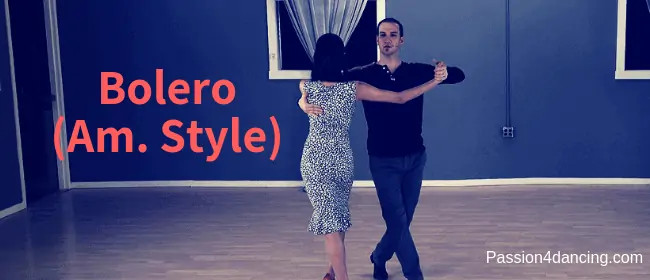 Bolero American Rhythm
Bolero American Rhythm
Alt Text: Graceful Bolero American Rhythm dance pose, showcasing its slow tempo, expressive movements, and elegant shaping.
3. What Are The International Latin Dances In Ballroom Latin Style?
International Latin dances in the Ballroom Latin style include Cha Cha (Int. Style), Samba (Int. Style), Rumba (Int. Style), Paso Doble (Int. Style), and Jive (Int. Style). These dances are often performed in competitions and emphasize technique, expression, and partnership.
Cha Cha (Int. Style)
The International style Latin Cha Cha dance resembles the other Cha Cha styles, but dancers step on a “straight leg” as they transfer weight. The moves are more “linear,” with a strong emphasis on the timing: 1, 2, 3, Cha Cha. According to the World Dance Council (WDC), the International style Cha Cha emphasizes precision and clarity of movement, making it a challenging and rewarding dance for competitive dancers.
Samba (Int. Style)
The International style Samba originated from the Brazilian Samba carnivals. This dance involves a “bounce” technique, where partners constantly bend and straighten their knees as they move. The “bouncing action” allows for a lot of body and hip movement. As highlighted by the Brazilian Samba Schools Association, the International style Samba captures the energy and spirit of the Brazilian carnivals, emphasizing rhythm and expression.
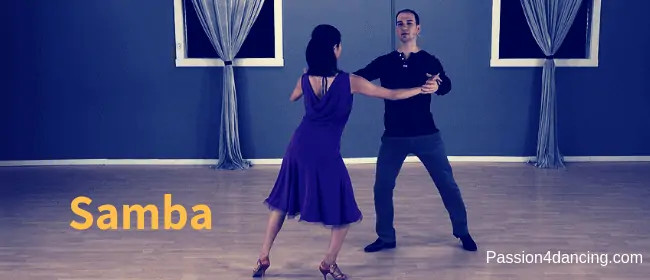 Samba dance
Samba dance
Alt Text: Lively Samba dance, showing its energetic bounce and vibrant movements.
Rumba (Int. Style)
The International style Rumba differs significantly from the Am. style. In this Rumba, dancers arrive mostly on a straight leg, and the figures are “linear.” There is a strong emphasis on sensual hip movement (figure 8) and arm extensions to express the slow tempo music. According to the Imperial Society of Teachers of Dancing (ISTD), the International style Rumba focuses on grace and sensuality, offering dancers a refined and expressive experience.
Paso Doble (Int. Style)
Paso Doble originated in Spain and is mainly performed in Int. Style competitions. This dance features a strong “marching” walk technique to cover the floor, with big shaping movements and “Apels” (stomping the foot strongly). The Spanish Dance Society notes that Paso Doble captures the drama and intensity of a Spanish bullfight, with dancers embodying the roles of matador and cape.
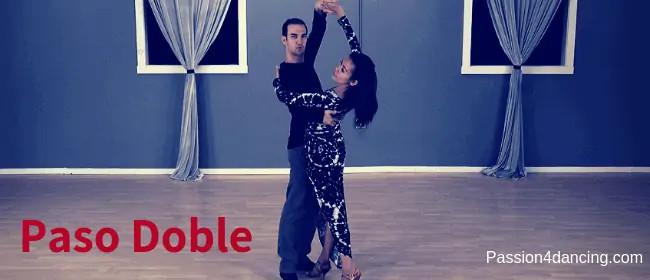 Paso Doble
Paso Doble
Alt Text: Dramatic Paso Doble dance pose, showing its strong marching steps, sharp movements, and Spanish influence.
Jive (Int. Style)
Jive is similar in character to Swing, but much faster. This dance includes many turns, spins, and kicks. Couples must keep their posture more forward than usual to keep up with the fast-paced music. The technique involves “hopping/jumping” on almost every step. According to the World Dance Council (WDC), Jive is a high-energy and dynamic dance that requires stamina and precision, making it a thrilling option for competitive dancers.
4. What Are The Key Differences Between Salsa On 1 And Salsa On 2?
The key difference between Salsa On 1 and Salsa On 2 lies in the timing of the basic step. In Salsa On 1, the lead dancer steps forward on the first beat of the music, while in Salsa On 2, the lead dancer steps back on the second beat. This difference in timing significantly impacts the feel and musicality of each style.
| Feature | Salsa On 1 (LA Style) | Salsa On 2 (New York Style) |
|---|---|---|
| Timing | Step forward on beat 1 | Step back on beat 2 |
| Style | Sharper, more direct | Smoother, more deliberate |
| Musicality | Emphasizes the overall rhythm | Connects with specific instruments like Bajo, Conga, and Clave |
| Common Moves | Many turns, spins, and crossbody lead moves | Similar moves, but timed differently |
| Best For | Beginners seeking a structured, energetic style | Dancers seeking a deeper connection with the music |
5. How Does The Club Style Cha Cha Differ From The Ballroom Style Cha Cha?
The Club Style Cha Cha and the Ballroom Style Cha Cha differ significantly in their technique, styling, and overall feel. The Club Style Cha Cha is more relaxed and improvisational, often danced in social settings with moves similar to Salsa and Merengue. In contrast, the Ballroom Style Cha Cha is more structured and precise, emphasizing sharp movements, strong hip action, and defined steps.
| Feature | Club Style Cha Cha | Ballroom Style Cha Cha |
|---|---|---|
| Setting | Social clubs, Latin dance parties | Ballroom dance floors, competitions |
| Technique | More relaxed, improvisational | More structured, precise |
| Moves | Similar to Salsa and Merengue | Distinct chasse steps, strong hip action |
| Styling | Less emphasis on specific technique | Strong emphasis on technique and defined movements |
| Overall Feel | Fun, social, and energetic | Technical, precise, and dynamic |
6. What Are The Benefits Of Learning Latin Dances?
Learning Latin dances offers numerous physical, mental, and social benefits. Physically, it improves cardiovascular health, coordination, flexibility, and muscle strength. Mentally, it enhances cognitive function, memory, and focus, while also reducing stress and boosting self-esteem. Socially, it provides opportunities to meet new people, build connections, and engage in a vibrant community.
Physical Benefits
Latin dances are a fantastic workout, improving overall fitness and well-being. The dynamic movements and rhythms engage various muscle groups, leading to increased strength, endurance, and flexibility.
- Cardiovascular Health: Latin dances elevate heart rate, improving circulation and cardiovascular health.
- Coordination: The intricate steps and patterns enhance coordination and balance.
- Flexibility: The movements stretch and lengthen muscles, increasing flexibility and range of motion.
- Muscle Strength: Engaging different muscle groups builds strength and tones the body.
Mental Benefits
Learning and performing Latin dances can significantly boost cognitive function and emotional well-being. The mental challenges of memorizing steps and coordinating movements enhance cognitive abilities, while the joy of dancing reduces stress and boosts self-esteem.
- Cognitive Function: Memorizing steps and patterns improves memory and cognitive function.
- Focus and Concentration: Focusing on the music and movements enhances concentration and attention span.
- Stress Reduction: Dancing releases endorphins, reducing stress and promoting relaxation.
- Self-Esteem: Mastering new steps and performing with confidence boosts self-esteem and self-image.
Social Benefits
Latin dances provide a wonderful opportunity to connect with others, build friendships, and engage in a supportive community. Whether you’re taking a class, attending a social dance, or performing on stage, Latin dancing fosters a sense of belonging and camaraderie.
- Meeting New People: Dance classes and social events provide opportunities to meet people with similar interests.
- Building Connections: Partner dancing fosters communication and trust, strengthening relationships.
- Community Engagement: Participating in dance events and performances connects you with a vibrant community of dancers.
- Social Confidence: Learning to dance and interact with others on the dance floor boosts social confidence.
7. What Are Some Tips For Beginners Learning Latin Dances?
For beginners learning Latin dances, it’s essential to start with the basics, practice regularly, find a good instructor, and be patient with yourself. Focus on mastering fundamental steps and techniques before moving on to more complex patterns. Don’t be afraid to make mistakes, and remember to have fun and enjoy the process.
- Start with the Basics: Begin with fundamental steps and techniques to build a solid foundation.
- Practice Regularly: Consistent practice helps reinforce muscle memory and improve coordination.
- Find a Good Instructor: A qualified instructor can provide personalized guidance and correct any errors.
- Be Patient: Learning to dance takes time and effort, so be patient with yourself and celebrate small victories.
- Have Fun: Enjoy the music, the movement, and the social interaction – dancing should be a joyful experience.
8. What Are Some Common Mistakes To Avoid When Learning Latin Dances?
When learning Latin dances, avoid common mistakes such as improper posture, incorrect timing, and lack of connection with your partner. Focus on maintaining good posture, listening to the music, and communicating effectively with your partner to create a seamless and enjoyable dance experience.
- Improper Posture: Maintain a tall, upright posture with relaxed shoulders and engaged core muscles.
- Incorrect Timing: Listen to the music and focus on executing steps with the correct timing and rhythm.
- Lack of Connection: Communicate with your partner through clear leads and follows, creating a harmonious connection.
- Rushing Steps: Take your time and execute each step with precision and control, avoiding rushing or skipping steps.
- Ignoring the Music: Pay attention to the nuances of the music and let it guide your movements and expressions.
9. How Can I Find Latin Dance Classes And Events Near Me In The USA?
Finding Latin dance classes and events near you in the USA is easier than ever. Online resources like ten-dance.com, dance studio directories, and social media groups can help you locate local dance studios, instructors, and events. Additionally, community centers, universities, and cultural organizations often offer Latin dance classes and workshops.
- Online Resources: Websites like ten-dance.com provide directories of dance studios and events in your area.
- Dance Studio Directories: Websites like Yelp and Google Maps can help you find local dance studios and read reviews.
- Social Media: Facebook groups and other social media platforms are great for finding local dance events and connecting with other dancers.
- Community Centers: Check with local community centers, universities, and cultural organizations for dance classes and workshops.
- Word of Mouth: Ask friends, family, and colleagues if they know of any good Latin dance classes or events in your area.
10. How Can Ten-Dance.Com Help Me Learn How To Hispanic Dance?
Ten-dance.com offers a comprehensive platform for learning how to Hispanic dance, providing access to a wide range of resources, including online lessons, tutorials, articles, and a supportive community. Whether you’re a beginner or an experienced dancer, ten-dance.com has everything you need to improve your skills and deepen your passion for Latin dance.
Extensive Online Lessons
Ten-dance.com boasts an extensive library of online lessons covering various Latin dance styles, from Salsa and Bachata to Merengue and Cha Cha. These lessons cater to all skill levels, with beginner-friendly tutorials that break down fundamental steps and techniques, as well as advanced lessons that delve into complex patterns and styling.
Expert Instruction
The online lessons at ten-dance.com are taught by experienced and qualified instructors who are passionate about Latin dance. These instructors provide clear, concise explanations, demonstrations, and personalized feedback to help you master the steps and techniques.
Supportive Community
Ten-dance.com fosters a supportive and inclusive community of dancers where you can connect with other learners, share your progress, ask questions, and receive encouragement. This community provides a valuable source of motivation and inspiration, helping you stay engaged and committed to your dance journey.
Comprehensive Resources
In addition to online lessons, ten-dance.com offers a wealth of comprehensive resources, including articles, tutorials, and guides on various aspects of Latin dance. These resources cover topics such as technique, styling, musicality, and cultural background, providing you with a well-rounded understanding of Latin dance.
Flexible Learning
Ten-dance.com offers a flexible learning environment that allows you to learn at your own pace, on your own schedule. You can access the online lessons and resources anytime, anywhere, making it easy to fit your dance practice into your busy lifestyle.
Ready to take your first step? Visit ten-dance.com today to explore our lessons, connect with our community, and start your Latin dance journey! For further assistance, feel free to reach out to us at:
Address: 60 Lincoln Center Plaza, New York, NY 10023, United States
Phone: +1 (212) 769-7000
Website: ten-dance.com

